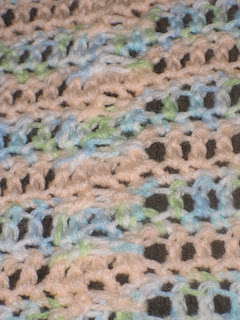
I was skeptical about this stitch when I began, but I grew to like it. The pictures in the book do not do this stitch justice because it is such a wide stitch pattern that you can't see the repeats in what is shown. The overall effect is gorgeous with vertical stripes through the stitch with a shell portion and a trellis portion. The stitch is lacy, and one I am likely to use in the future. I am glad that I did this in a solid color because it allows the beauty of the stitch to come through. Using variegated yarn or doing stripes in this stitch would overshadow the stitch, so I highly recommend solid colored yarn for this stitch. One problem I encountered while working this stitch, is that if you don't pay attention to what you are doing, it is easy to do a shell where you are simply supposed to do one double crochet. If you are actually looking at your work it is easy to tell where to do each portion, but if you only check it every few rows (like I was doing), you might end up having to pull out several rows. This stitch would make a pretty scarf begun with a short chain.

Here's how to make it:
Chain 92 then work the stitch until it is square and add this border:
Round 1: sc around, 3 sc in each corner
Round 2: (dc, ch 1, sk 1) around, (dc, ch 1, dc, ch 1, dc) in each corner
Round 3: (dc, ch 1, sk 1) around, (dc, ch 1, dc, ch 1, dc) in each corner
Round 4: (dc, ch 1, sk 1) around, (dc, ch 1, dc, ch 1, dc) in each corner
Round 5: (5 dc, sc) around in each dc, 3 sc in each corner
I made this using Lion Brand Pound of Love Lavender yarn with a J hook.
 Round 1: sc around, 3 sc in each corner (pink)
Round 1: sc around, 3 sc in each corner (pink)























